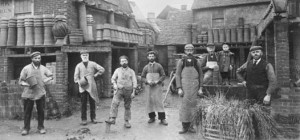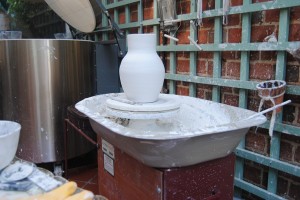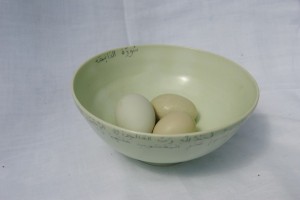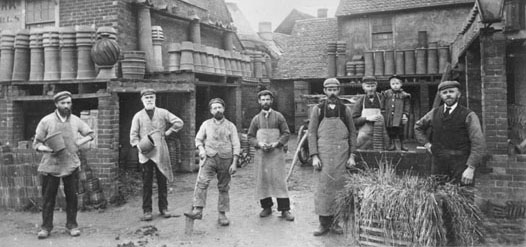
‘Sussex Pottery’ conjures up the image of that particular type of earthenware or ‘brownware’ as it is affectionately known by some, produced in the county from the late 18th century up until the 20th. Indeed, pottery has been made in the county since medieval times, serving the rural communities with deeply functional items such as flagons, flasks, hot water bottles, butter churns and even roof tiles; humble and beautiful, in their own right, to the farming villages which they served.
I learned this type of pottery at school under the expert tuition of a devoted potter, using clay from Stoke, St Thomas’ body. Handbuilding, coiling, throwing and rolling were the order of the day; yet I had a yearning for something else. I wanted to make a different type of vessel that would combine functionality with beauty. We experimented with glazes, but none of the colours spoke of the tranquillity and serenity that I sought. I knew about porcelain, but the cost was prohibitive. What I didn’t know, until decades later, was that a white body was needed to carry the celadon hues that I imagined.
 Moving on several decades, I now have a quiet studio where I work mainly in porcelain. All the bowls are hand thrown on the wheel, the glazes made up to adapted recipes and then fired at around 1200 degrees centigrade in an electric kiln. In addition to learning to throw in porcelain, I study classical Arabic so that I can read and write out the texts onto the porcelain. Historically, the writing materials would consist of colbalt brushwork under the glaze or lustres painted on the surface. I use both, in addition to a specially adapted ceramic pen to write more extensive texts, between the first and the second firing. It’s a time consuming business, but one that gives me the greatest pleasure. Due to the exchange of artistry between the East and the West, along the Silk Road, Arabic texts were found on ceremonial
Moving on several decades, I now have a quiet studio where I work mainly in porcelain. All the bowls are hand thrown on the wheel, the glazes made up to adapted recipes and then fired at around 1200 degrees centigrade in an electric kiln. In addition to learning to throw in porcelain, I study classical Arabic so that I can read and write out the texts onto the porcelain. Historically, the writing materials would consist of colbalt brushwork under the glaze or lustres painted on the surface. I use both, in addition to a specially adapted ceramic pen to write more extensive texts, between the first and the second firing. It’s a time consuming business, but one that gives me the greatest pleasure. Due to the exchange of artistry between the East and the West, along the Silk Road, Arabic texts were found on ceremonial bowls in the Imperial Court during the Tang Dynasty and the highly prized material of porcelain made its way out of China in an Easterly direction. It is this particular exchange of ideas that fascinates me; the influence of one culture upon another. Whilst my work does not fit in the mould of what is viewed as ‘Sussex Pottery’ (I don’t allow brown glazes in the studio) I hope that the intrigue of the studio will unfold on these pages and the images will provide some of the tranquillity, in form and colour, that I sought.
bowls in the Imperial Court during the Tang Dynasty and the highly prized material of porcelain made its way out of China in an Easterly direction. It is this particular exchange of ideas that fascinates me; the influence of one culture upon another. Whilst my work does not fit in the mould of what is viewed as ‘Sussex Pottery’ (I don’t allow brown glazes in the studio) I hope that the intrigue of the studio will unfold on these pages and the images will provide some of the tranquillity, in form and colour, that I sought.
On a less esoteric journey, I will unfold my first foray into using a reduction kiln where the oxygen is leached out of the kiln, causing the fine and subtle array of celadons that were developed in China, Japan and Korea. This will be the real alchemy of ceramics and I look forward to sharing it with you.

